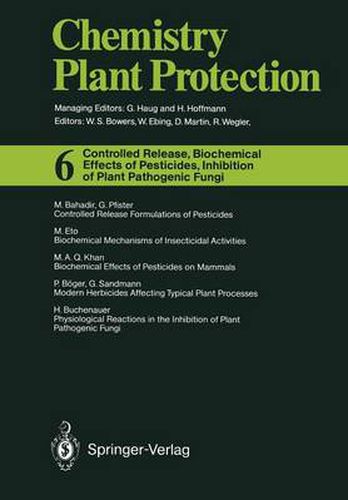Readings Newsletter
Become a Readings Member to make your shopping experience even easier.
Sign in or sign up for free!
You’re not far away from qualifying for FREE standard shipping within Australia
You’ve qualified for FREE standard shipping within Australia
The cart is loading…






This title is printed to order. This book may have been self-published. If so, we cannot guarantee the quality of the content. In the main most books will have gone through the editing process however some may not. We therefore suggest that you be aware of this before ordering this book. If in doubt check either the author or publisher’s details as we are unable to accept any returns unless they are faulty. Please contact us if you have any questions.
Since the middle of the Sixties, new types of formulation for biologically active com pounds have been developed, which have been introduced into the literature under the term Controlled Release Formulations (CRF). Stimulated by results from former and successful pharmaceutical research, which was engaged in the production of prepa rations with protracted effects (introduction onto the market in the year 1952 of D amphetamine in the form of pellets, coated to varying degrees with fats and waxes) 1), experiments were carried out to transfer the prolongation of effectiveness to pesticidal substances also, by means of a depot formulation. Initial work was concerned with the production of protective coatings for sonar systems in marine ecosystems. By means of antifouling paints or rubber coatings containing tri-n-butyl-tin oxide (TBTO), the growth of marine organisms on sonar domes, buoys and hulls in the water could be effectively prevented 2. 3). Controlled release formUlations of pesticides are defined as depot systems which continuously release their toxic constituents into the environment over a specified period of time (usually months to years) 4). According to this definition, such formu lations can be successfully employed where a chronic exposure to biologically active compounds is required over a longer period. The following hypothetical example is intended to illustrate this 5). In Fig. 1, the duration of activity of a non-persistent pesticide with a loss rate under environmental conditions of t1/2 = 15 days, is graphically illustrated.
$9.00 standard shipping within Australia
FREE standard shipping within Australia for orders over $100.00
Express & International shipping calculated at checkout
This title is printed to order. This book may have been self-published. If so, we cannot guarantee the quality of the content. In the main most books will have gone through the editing process however some may not. We therefore suggest that you be aware of this before ordering this book. If in doubt check either the author or publisher’s details as we are unable to accept any returns unless they are faulty. Please contact us if you have any questions.
Since the middle of the Sixties, new types of formulation for biologically active com pounds have been developed, which have been introduced into the literature under the term Controlled Release Formulations (CRF). Stimulated by results from former and successful pharmaceutical research, which was engaged in the production of prepa rations with protracted effects (introduction onto the market in the year 1952 of D amphetamine in the form of pellets, coated to varying degrees with fats and waxes) 1), experiments were carried out to transfer the prolongation of effectiveness to pesticidal substances also, by means of a depot formulation. Initial work was concerned with the production of protective coatings for sonar systems in marine ecosystems. By means of antifouling paints or rubber coatings containing tri-n-butyl-tin oxide (TBTO), the growth of marine organisms on sonar domes, buoys and hulls in the water could be effectively prevented 2. 3). Controlled release formUlations of pesticides are defined as depot systems which continuously release their toxic constituents into the environment over a specified period of time (usually months to years) 4). According to this definition, such formu lations can be successfully employed where a chronic exposure to biologically active compounds is required over a longer period. The following hypothetical example is intended to illustrate this 5). In Fig. 1, the duration of activity of a non-persistent pesticide with a loss rate under environmental conditions of t1/2 = 15 days, is graphically illustrated.